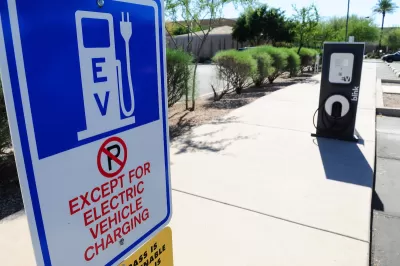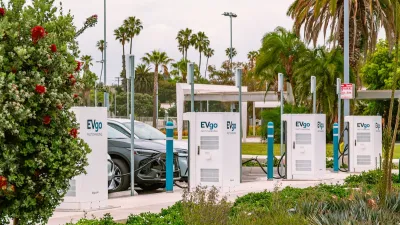A lack of access to charging infrastructure is holding back EV adoption in many US cities.

Writing in PC Mag, Emily Dreibelbis, highlights a paradox: while many electric vehicles are designed for urban environments, “Early adopters are primarily wealthy, single-family homeowners who can power up on private chargers versus those in rental property garages.”
Dreibelbis points out that by 2030, 60 percent of EVs will be in suburbs and “92% of chargers nationwide will be in single-family homes, according to a June 2023 DOE report.” The latter statistic reveals a major reason why urban Americans are less likely to buy electric cars: a lack of charging infrastructure.
[F]or now, EVs are stuck in the suburbs thanks to public charging limitations and a car culture where bigger means better.
The lack of accessible EV chargers in urban areas means urban dwellers can’t benefit from their advantages in the very places they would be most efficient. “When it comes to charging in urban areas, Europe has a few tricks the US hasn't embraced yet, such as converting existing light poles to charging stations. They're BYOC (bring your own cord); drivers pull up and plug in with their own equipment.”
Until urban infrastructure catches up, the suburbs will play a key role in EV adoption, Dreibelbis writes. “They prove that when charging is easy and available, and the driver considers the vehicle affordable, people love EVs.”
FULL STORY: Why Electric Cars Are Built for Cities, But Only Booming in the Suburbs

Study: Maui’s Plan to Convert Vacation Rentals to Long-Term Housing Could Cause Nearly $1 Billion Economic Loss
The plan would reduce visitor accommodation by 25,% resulting in 1,900 jobs lost.

North Texas Transit Leaders Tout Benefits of TOD for Growing Region
At a summit focused on transit-oriented development, policymakers discussed how North Texas’ expanded light rail system can serve as a tool for economic growth.

Using Old Oil and Gas Wells for Green Energy Storage
Penn State researchers have found that repurposing abandoned oil and gas wells for geothermal-assisted compressed-air energy storage can boost efficiency, reduce environmental risks, and support clean energy and job transitions.

Private Donations Propel Early Restoration of Palisades Playground
Los Angeles has secured over $1.3 million in private funding to restore the Pacific Palisades playground months ahead of schedule, creating a modern, accessible space that supports community healing after recent wildfires.

From Blight to Benefit: Early Results From California’s Equitable Cleanup Program
The Equitable Community Revitalization Grant (ECRG) program is reshaping brownfield redevelopment by prioritizing projects in low-income and environmental justice communities, emphasizing equity, transparency, and community benefits.

Planting Relief: Tackling Las Vegas Heat One Tree at a Time
Nevada Plants, a Las Vegas-based nonprofit, is combating the city’s extreme urban heat by giving away trees to residents in underserved neighborhoods, promoting shade, sustainability, and community health.
Urban Design for Planners 1: Software Tools
This six-course series explores essential urban design concepts using open source software and equips planners with the tools they need to participate fully in the urban design process.
Planning for Universal Design
Learn the tools for implementing Universal Design in planning regulations.
Ascent Environmental
Borough of Carlisle
Institute for Housing and Urban Development Studies (IHS)
City of Grandview
Harvard GSD Executive Education
Toledo-Lucas County Plan Commissions
Salt Lake City
NYU Wagner Graduate School of Public Service





























